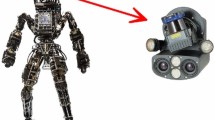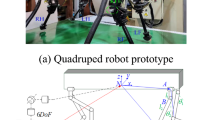Abstract
In the present study we attempt to induce a quadruped robot to walk dynamically on irregular terrain and run on flat terrain by using a nervous system model. For dynamic walking on irregular terrain, we employ a control system involving a neural oscillator network, a stretch reflex and a flexor reflex. Stable dynamic walking when obstructions to swinging legs are present is made possible by the flexor reflex and the crossed extension reflex. A modification of the single driving input to the neural oscillator network makes it possible for the robot to walk up a step. For running on flat terrain, we combine a spring mechanism and the neural oscillator network. It became clear in this study that the matching of two oscillations by the spring-mass system and the neural oscillator network is important in order to keep jumping in a pronk gait. The present study also shows that entrainment between neural oscillators causes the running gait to change from pronk to bound. This finding renders running fairly easy to attain in a bound gait. It must be noticed that the flexible and robust dynamic walking on irregular terrain and the transition of the running gait are realized by the modification of a few parameters in the neural oscillator network.
Similar content being viewed by others
References
Akiyama, S. and Kimura, H. 1995. Dynamic quadruped walk using neural oscillators—realization of pace and trot—. In Proc. of 13th Annual Conf. of RSJ, pp. 227-228.
Bachanam, J.T. and Grillner, S. 1987. Newly identified glutamate interneurons and their role in locomotion in lamprey spinal cord. Science, 236:312-314.
Beer, R.D., Chiel, H.J., and Sterling, L.S. 1991. An artificial insect. American Scientist, 79:444-452.
Buehler, M., Battaglia, R., Cocosco, A., Hawker, G., Sarkis, J., and Yamazaki, K. 1998. Scout: A simple quadruped that walks, climbs and runs. In Proc. of ICRA98, pp. 1707-1712.
Collins, J.J. and Richmond, S.A. 1994. Hard-wired central pattern generators for quadrupedal locomotion. Biological Cybernetics, 71:375-385.
Collins, J.J. and Stewart, I.N. 1992. Symmetry-breaking bifurcation: A possible mechanism for 2:1 frequency-locking in animal locomotion. Journal of Mathematical Biology, 30:827-838.
Collins, J.J. and Stewart, I.N. 1993. Coupled nonlinear oscillators and the symmetries of animal gaits. Journal of Nonlinear Science, 3:349-392.
Drew, T., Jiang, W., Kably, B., and Lavoie, S. 1996. Role of the motor cortex in the control of visually triggered gait modifications. Can. Journal of Physiol. Pharmacol., 74:426-442.
Fukuoka, Y., Nakamura, H., and Kimura, H. 1999. Biologically-inspired adaptive dynamic walking of the quadruped on irregular terrain. In Proc. of IROS99, accepted.
Furusho, J., Sano, A., Sakaguchi, M., and Koizumi, E. 1995. Realization of bounce gait in a quadruped robot with articular-joint-type legs. In Proc. of ICRA95, pp. 697-702.
Grillner, S. 1981. Control of locomotion in bipeds, tetrapods and fish. In Handbook of Physiology, American Physiological Society: Bethesda, MD, vol. II, pp. 1179-1236.
Hiebert, G., Gorassini, M., Jiang, W., Prochazka, A., and Pearson, K. 1994. Corrective responses to loss of ground support during walking II, comparison of intact and chronic spinal cats. Journal of Neurophys., 71:611-622.
Ijspeert, A.J., Hallman, J., and Willshaw, D. 1998. From lampreys to salamanders: Evolving neural controllers for swimming and walking. In Proc. of SAB98, pp. 390-399.
Ilg, W., Albiez, J., Jedele, H., Berns, K., and Dillmann, R. 1999. Adaptive periodic movement control for the four legged walking machine BISAM. In Proc. of ICRA99, pp. 2354-2359.
Kajita, S. and Tani, K. 1996. Control of dynamic biped locomotion based on realtime sensing of the ground profile. Journal of RSJ, 14(7):1062-1069.
Katoh, R. and Mori, M. 1984. Control method of biped locomotion giving asymptotic stability of trajectory. Automatica, 20(4):405-411.
Kimura, H., Shimoyama, I., and Miura, H. 1990. Dynamics in the dynamic walk of a quadruped robot. RSJ. Advanced Robotics, 4(3):283-301.
Lewis, M.A. 1996. Self-organization of locomotory controllers in robots and animals, Ph.D. Dissertation, Electrical Eng., Univ. of Southern California.
Matsuoka, K. 1987. Mechanisms of frequency and pattern control in the neural rhythm generators. Biological Cybernetics, 56:345-353.
Miura, H. and Shimoyama, I. 1984. Dynamical walk of biped locomotion. Int. Journal of Robotics Research, 3(2):60-74.
Miyakoshi, S., Taga, G., Kuniyoshi, Y., and Nagakubo, A. 1998. Three dimensional bipedal stepping motion using neural oscillators—towards humanoid motion in the real world. In Proc. of IROS98, pp. 84-89.
Raibert, M.H. 1986. Legged Robots That Balance, The MIT Press: Cambridge, MA.
Shik, M.L. and Orlovsky, G.N. 1976. Neurophysiology of locomotor automatism. Physiol. Review, 56:465-501.
Stent, G.S., Kristan, W.B. Jr., Friesen, W.D., Ort, C.A.A., Poon, M., and Carabrese, R.L. 1978. Neuronal generation of the leech swimming movement. Science, 200:1348-1357.
Taga, G. 1995. A model of the neuro-musculo-skeletal system for human locomotion II. Real-time adaptability under various constraints. Biological Cybernetics, 73:113-121.
Taga, G., Yamaguchi, Y., and SHimizu, H. 1991. Self-organized control of bipedal locomotion by neural oscillators. Biological Cybernetics, 65:147-159.
Yamaguchi, J., Takanishi, A., and Kato, I. 1994. Development of a biped walking robot adapting to a horizontally uneven surface. In Proc. of IROS95, pp. 1030-1037.
Yoneda, K. 1987. The development of biped walking robot for HC-plane. In Proc. of 5th Annual Conf. of RSJ, pp. 585-586.
Yoneda, K., Iiyama, H., and Hirose, S. 1994. Sky-hook suspension control of a quadruped walking vehicle. In Proc. of ICRA94, pp. 999-1004.
Yuasa, H. and Ito, M. 1990. Coordination of many oscillators and generation of locomotory patterns. Biological Cybernetics, 63:177-184.
Author information
Authors and Affiliations
Rights and permissions
About this article
Cite this article
Kimura, H., Akiyama, S. & Sakurama, K. Realization of Dynamic Walking and Running of the Quadruped Using Neural Oscillator. Autonomous Robots 7, 247–258 (1999). https://doi.org/10.1023/A:1008924521542
Issue Date:
DOI: https://doi.org/10.1023/A:1008924521542




